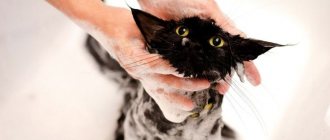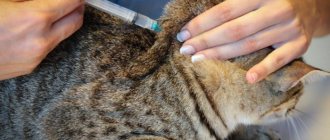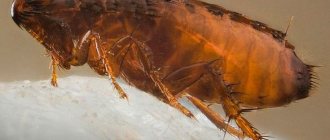10998Administration
1
Almost every owner who has cats has encountered a problem - the animal begins to vigorously scratch its ears, sometimes even to the point of bleeding. The most common reasons why a cat's ears itch are given in this article.
Ear scratching is a red flag that may indicate that your pet is sick. To avoid such problems, you need to regularly examine the animal to assess its health. Failure to promptly treat ear diseases and infections can cause your cat to develop serious hearing problems for life, including complete deafness.
© shutterstock
Hematomas of the auricle
A cat's ears are a very sensitive organ.
Hematomas occur when the ear is damaged when blood accumulates in the cavity caused by mechanical force (bite, bruise, prolonged compression). Symptoms:
— When injured, the ear swells, increases in size, and the cat begins to shake its head.
- The bruise is clearly visible.
- The ear cartilage becomes hot to the touch (the local temperature rises).
— A limited soft swelling is detected, the size of which depends on the degree of damage to the blood vessels.
- Fluctuation and pain when feeling the swelling.
— The pet’s general condition, appetite, and physical activity depend on the severity of the damage. With mild hemorrhage, the owner does not notice a decrease in appetite. In severe forms of hematoma, the animal may refuse to eat due to pain and be in a depressed, lethargic state.
Treatment:
1. For small hematomas, cold is indicated in the first hours after injury. Frozen foods from the freezer wrapped in cloth are suitable for this purpose. You can cool the damaged ear for 10 - 15 minutes.
2. If there is an open wound, it is treated with disinfectants. To reduce blood leakage, a pressure bandage is applied to the ear.
3. For extensive hematomas, due to the fact that there is a high risk of infection, the most effective treatment method is surgical.
4. In the treatment of the disease, anti-inflammatory and antibacterial ointments are widely used: levomykolev, synthomycin, chloramphenicol.
5. For suppuration, ichthyol and Vishnevsky ointment are used.
6. Additionally, if the hematoma becomes infected, the animal is prescribed a course of antibacterial therapy. For this purpose, penicillin antibiotics, tetracyclines, and cephalosporins are used.
============================================================================================================================================================================================
Petstory service - an online assistant for cat owners
After a couple of days of self-treatment, is your cat still scratching his ears? Contact your veterinarian immediately. Install the Petstory service on your smartphone, and you can almost immediately contact a specialist to find out what to do next.
Does the veterinarian insist on the need for an in-person consultation and laboratory tests? Using the service, you can make an appointment remotely at any veterinary clinic in your city, and you can choose an institution with the optimal cost of admission for you.
Download the specialized application for pet owners Petstory on the IOS and Android platforms using the link – https://petstory.ru/prilozhenie-konsultacija-veterinar/.
Subscribe to our Telegram channel. In it we publish the main things from the life of Saratov and the region with comments
Ear scabies (otodectosis)
A disease caused by microscopic skin-eating mites. They parasitize on the inner surface of the ear and in the external auditory canal.
Symptoms:
— When infected with ticks, the cat shakes its head, scratches its ears almost constantly, and combs them.
— Characteristic black plaque and scabs appear in the ears.
— In the purulent form, a brown purulent mass with an unpleasant odor is released from the ears, and the hair in the lower part of the ear sticks together.
Treatment:
1. Before visiting a veterinarian, it is advisable not to clean your pet’s ears or instill medications, so as not to blur the clinical picture.
2. As a last resort, you can use ear drops “Bars”, “Otibiovin” and the drug “Tsipam” and show the animal to a veterinarian.
3. Amitraz preparations (for example, Amitrazin, Tsipam, etc.), hexachlorane (Aurikan), as well as preparations for acaricidal and insecticidal treatment of farm animals (Neostomozan) are good at killing ticks.
============================================================================================================================================================================================
Treatment
Of course, if your four-legged friend becomes infected, you should seek help from a specialist. But how can you fight diseases on your own after being diagnosed by a veterinarian?
At home
For each disease, the veterinarian prescribes separate drops, antiseptics or antibiotics, depending on the source of infection and the characteristics of the cat’s body. When choosing treatment at home, you must strictly follow the prescription and prescribed recommendations.
Use prescribed medications to treat wounds, ears and strengthen the animal’s immunity. Monitor his well-being, take care of a comfortable environment.
In the clinic
In advanced cases, the pet needs to stay in the clinic. With the help of surgery, hematomas and abscesses can be removed. After surgery, the animal may remain in the hospital. This is necessary to monitor his well-being and health in order to prevent complications.
Your veterinarian can treat your pet's infection and help remove parasites.
Ear check
Inflammation of the outer, middle and inner ear
Inflammation of the outer ear is usually the result of untreated or undertreated otodectosis. In addition, the cause of the disease can be sulfur plugs, a foreign object, or cold water.
Symptoms:
— At an early stage, the skin looks irritated and red.
— The cat rubs the sore ear (or ears with bilateral otitis media) with its paw, holding the ear folded and pressed to the head.
— After some time, the ear begins to hurt. If the pain is acute, “shooting,” the cat suddenly jumps up, screams sharply, and looks around in fear. If the pain is aching, the cat does not allow the ear to be touched, avoids stroking the head, and presses the sore ear to the bedding.
- Scratches, grooves, pimples, ulcers are noticeable on the skin;
— The cat constantly shakes its head, does not turn its sore ear to the rustle;
- If the facial nerve is damaged, the eyelid, lip or ear may sag, which indicates partial paralysis.
— If purulent otitis media develops, cats have a leak from the ear, something squelches and gurgles inside, especially when touched.
— An obsessive unpleasant odor emanates from a cat, especially from the ear.
- In severe cases, the temperature rises 1-2 degrees above normal, the pet loses appetite, does not want to play and communicate. Many cats become irritable and constantly scream and meow.
Treatment:
The first step is to remove the hair from the inner surface of the ear.
- Using a cotton swab, clean the external auditory canal from accumulated wax and purulent discharge. Cotton wool can be moistened in a warm solution of hydrogen peroxide (3%), boric acid (2%) or furatsilin solution.
- Then the remaining moisture from the rinsing is thoroughly blotted with a gauze cloth to dry the ear.
- Medicinal drops prescribed by the veterinarian are instilled into the auricle.
- Sometimes it is necessary to carry out a novocaine blockade to reduce pain. This procedure can only be performed by a qualified specialist in a manner that is safe for your pet’s health.
- A course of antibiotic therapy is prescribed for 5-7 days.
- Adequate nutrition with easily digestible feed, introduction of vitamin and mineral supplements into the diet.
============================================================================================================================================================================================
Preventing skin problems in cats
Regular treatment for external and internal parasites is a prerequisite for the prevention of diseases in cats. In the warm season, it is especially important to protect your pet from fleas and ticks, and in some cases (warm climate, contact with stray animals, etc.) treatment should be year-round. You need to use safe products to which the cat is not allergic, and weigh the animals before treatment.
Healthy, well-groomed pets rarely become infected with fungal infections. Therefore, conditions of detention are important. In addition to protection from external parasites, the cat should regularly receive anthelmintic, be vaccinated in a timely manner, and for older animals an annual medical examination with blood tests is also relevant.
Balanced, nutritious feeding also helps maintain healthy skin and coat, regardless of whether you prefer natural food or commercial food. A healthy cat should have a “glossy” appearance and not suffer from year-round shedding, mats or dandruff.
Some diseases, such as autoimmune diseases or allergic reactions, cannot be predicted or prevented. In this case, the owner can do only one thing - promptly contact a specialist if the cat develops scratching or other skin problems.
How to help your pet at home
To eliminate unpleasant symptoms, it is recommended to use compresses or wipes based on medicinal herbs.
Effective recipes:
- Calendula. Pour 30g of plant collection into 250 ml of water. Boil the mixture for 15 minutes, without letting it boil too much. Leave for 2 hours, peel. Use as a rub, lubricating scratches and wounds on the neck.
- Chamomile. Pour 30 g of herb into 200 ml of boiling water and leave for 30 minutes. Cleanse and use as a compress on wounds and ulcers. Use the product 3-4 times a day until complete recovery.
If the cat continues to actively lick the inflamed areas, which interferes with their healing, a veterinary cone or Elizabethan collar should be used.
Complications of IT
- Periauricular cellulitis is manifested by hyperemia, edema, and local hyperthermia of the skin around the auricle. Pain is usually mild and systemic symptoms are usually absent, which helps distinguish cellulitis from malignant otitis externa.
- Malignant otitis externa (necrotizing) is a severe, potentially fatal complication of bacterial Otitis. It is most common in older patients with diabetes or people with weakened immune systems. In this case, the infection spreads to the base of the skull and surrounding soft tissue. There is severe otalgia and discharge from the ear. In the NSP - granulation, edema, erythema, necrosis (death) of the NSP.
What to do when a cat scratches its ear until it bleeds
Every cat must take care of itself. These animals are very clean and clean their fur, wash themselves often, and scratch their ears. But every owner should know what to do when a cat scratches its ear until it bleeds. This also happens. This occurs mainly due to ear diseases. Unfortunately, they happen quite often in animals. And the cat is trying to show you that something is bothering him, he feels discomfort and pain. He cannot solve this problem on his own, and the owner’s task is to detect health problems and various diseases in a timely manner.
Main reasons
Itching can be caused by both internal and external causes. Most often this is due to the presence of fleas, even if they could not be identified during a visual inspection.
Moreover, irritation on the skin from their bites can persist for 1-1.5 months after the pet has been treated.
The waste products of helminths, as well as the toxins released by them, provoke skin rashes and allergic reactions.
There are other provoking factors that cause an unpleasant symptom. Each of them can be manifested by characteristic itching, but in addition to this, there are other symptoms that make it possible to diagnose the pathology.
Therefore, it is necessary to consider all possible causes and become familiar with their characteristic features.
Helminths
Parasites have a negative impact not only on the digestive organs, but also contribute to the loss of essential nutrients.
As a result, the cat does not receive enough of the necessary components from food, which leads to increased dryness of the epidermis and the appearance of dandruff. This feature provokes itching. Therefore, the pet tries to lick itself more often and more intensely in order to eliminate the unpleasant symptom.
The waste products of helminths, as well as the toxins released by them, provoke skin rashes and an allergic reaction.
Helminthiasis occurs in both adults and kittens. Infection occurs through flea bites and contact with an infected animal.
Parasites can be transmitted to humans and other pets ; treatment should be carried out on everyone at the same time.
Characteristic features:
- faded, matted fur;
- peeling of the epidermis;
- changes in taste preferences due to digestive failure;
- sour eyes;
- unusual behavior.
For prevention purposes, it is recommended to vaccinate or regularly give special suspensions, which can be purchased at a veterinary pharmacy.
Ringworm
This fungal disease also causes annoying itching in cats. The provoking factor for development is a lowered immune system and an unbalanced diet.
Ringworm causes annoying itching in cats
Infection can occur through contact with a sick street animal, as well as from an owner who brings spores of a pathogenic fungus on his clothes. Lack of treatment can cause the death of your pet.
The danger of ringworm is that it can be transmitted to humans. Therefore, therapy should be started at the first signs to avoid serious complications.
Additional signs:
- the fur falls out in clumps;
- bald patches appear on the body;
- inflamed areas become covered with scales and become inflamed;
- the pet constantly shows anxiety;
- the wool is greasy, matted, without a healthy shine;
- claws become deformed;
- lack of interest in food;
- In place of bald patches, ulcers form.
The general condition of the sick animal is depressed; when licking and scratching the ulcers, the animal may meow pitifully, as this causes pain.
Lice, ticks, fleas and skin parasites
All external parasites not only bite the animal, causing skin irritation, but also leave behind waste products, which provokes an unpleasant symptom.
The cat scratched its neck until it bled: what to do, what to apply, how to treat it
Skin diseases of cats are a common phenomenon, since the upper layer of the epidermis performs a protective function and blocks the access of pathogens to the animal’s body.
But the pet’s immune system is not always able to withstand all external and internal provoking factors.
It is necessary to be attentive to your pet and promptly respond to any changes in its behavior. If a cat scratches its neck until it hurts, you first need to recognize the underlying cause of the disease.
Our doctors
Gogolev Vasily Gennadievich
Doctor - otorhinolaryngologist
20 years of experience
Make an appointment
Zharova Galina Gennadievna
Doctor - otorhinolaryngologist, member of the European Society of Rhinologists, doctor of the highest category
40 years of experience
Make an appointment
Debryansky Vladimir Alekseevich
Doctor - otorhinolaryngologist, doctor of the highest category
34 years of experience
Make an appointment











